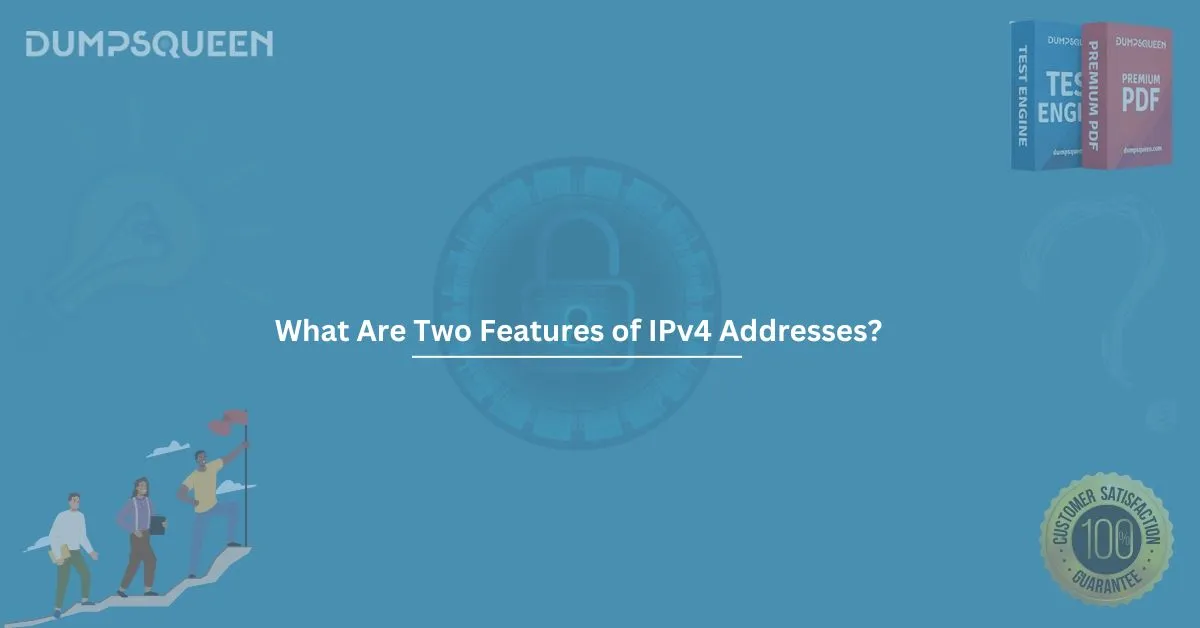Internet Protocol version 4, commonly known as IPv4, forms the foundation of how devices communicate across networks. Despite the advent of IPv6, IPv4 continues to dominate internet communication and networking infrastructures due to its stability, reliability, and compatibility with most devices.
If you're preparing for IT certifications or just want to understand networking fundamentals better, this guide will help you answer one important question: what are two features of IPv4 addresses?
At DumpsQueen Official, we ensure our readers and learners receive accurate, exam-relevant, and easy-to-understand content. So, let’s explore the top features of IPv4 and why they’re important in the digital world.
Understanding IPv4 Addresses
IPv4 addresses are a fundamental part of how data is routed across networks. Each IPv4 address is unique and identifies a device within a network. These addresses consist of 32 bits, typically displayed in dotted decimal notation, such as 192.168.1.1.
The format is split into four octets, and each octet is made of 8 bits, making the address human-readable and structured for hierarchical identification of devices across networks.
What Are Two Features of IPv4 Addresses?
Let’s now focus on the core question: what are two features of IPv4 addresses? The answer lies in two defining technical characteristics that set IPv4 apart.
1. 32-bit Address Structure
One of the key features of IPv4 is its 32-bit length. This structure provides approximately 4.3 billion unique IP addresses. While that may sound like a large number, the rapid growth of the internet and connected devices has made address exhaustion a real concern—one of the reasons IPv6 was developed.
This 32-bit system is broken down into four sections, or octets, each capable of representing values between 0 and 255. These are separated by dots in decimal format, making the addresses easier to read.
For example:
11000000.10101000.00000001.00000001 (binary)
is written as 192.168.1.1 in dotted decimal form.
This fixed-length structure provides consistency, predictability, and ease of parsing for both network devices and administrators.
2. Supports Hierarchical Addressing Using Subnet Masks
Another essential feature of IPv4 is subnetting, which allows for hierarchical addressing. This means an IPv4 address can be split into two parts: the Network ID and the Host ID. This division is made possible through a subnet mask.
A subnet mask helps routers identify which part of the IP address corresponds to the network and which to the specific device within that network.
For example:
IP Address: 192.168.10.5
Subnet Mask: 255.255.255.0
Network ID: 192.168.10.0
Host ID: 0.0.0.5
This hierarchy improves routing efficiency, enables better management of address allocations, and supports the scalability of network infrastructure.
Additional Features of IPv4 Addresses
While the two features above directly address the core question, understanding additional aspects of IPv4 can strengthen your grasp of networking essentials and help with exam readiness.
Class-Based IP Addressing
IPv4 uses a classful address system, grouping addresses into five major categories: A, B, C, D, and E. Each class is intended for specific types of networks and devices.
Class A: 1.0.0.0 to 126.0.0.0 – Large networks
Class B: 128.0.0.0 to 191.255.0.0 – Medium networks
Class C: 192.0.0.0 to 223.255.255.0 – Small networks
Class D: 224.0.0.0 to 239.255.255.255 – Multicast
Class E: 240.0.0.0 to 255.255.255.255 – Reserved
Private and Public IP Addresses
IPv4 addresses are also categorized into private and public. Private IPs are used for internal communications within local networks and are not routable over the public internet. This helps conserve the number of public IPs needed and adds a layer of internal network security.
Private IP Ranges:
Class A: 10.0.0.0 – 10.255.255.255
Class B: 172.16.0.0 – 172.31.255.255
Class C: 192.168.0.0 – 192.168.255.255
Connectionless Protocol
IPv4 is a connectionless protocol, meaning it does not require a fixed path or session before sending data packets. Each packet is treated independently, allowing quicker and more flexible communication, especially in large and dynamic networks.
Statelessness
Being stateless means IPv4 does not retain session information between requests. This simplicity reduces overhead and makes the protocol more scalable for basic tasks like web browsing or file transfers.
Limitations of IPv4
Although IPv4 has enabled the expansion of the internet for decades, it has a few limitations that are important to know for your IT exams and real-world applications.
1. Address Exhaustion
The finite number of IPv4 addresses has led to the widespread use of Network Address Translation (NAT) to allow multiple devices to share a single public IP.
2. No Native Security Features
Unlike IPv6, IPv4 does not include in-built encryption or authentication mechanisms, requiring separate protocols like IPSec for security.
3. No Built-In Mobility
IPv4 lacks the ability to seamlessly support mobile devices moving between networks without interruption, which is another area IPv6 improves upon.
Why Is IPv4 Still in Use?
Despite its limitations, IPv4 continues to be the most widely deployed Internet Protocol version in the world. Its enduring popularity is due to:
- Existing infrastructure and hardware compatibility
- Simple implementation and low costs
- Well-established support across platforms and devices
For exam candidates, understanding IPv4 remains essential, as many certification tests, including CompTIA Network+, Cisco CCNA, and Microsoft exams, still include a significant focus on IPv4.
IPv4 Address Structure Recap
Let’s summarize the structure for clarity:
- Length: 32 bits
- Representation: Dotted decimal (e.g., 172.16.254.1)
- Components: Network ID + Host ID
- Subnetting: Enables address segmentation
- Total Possible Addresses: Approximately 4.3 billion
Common Use Cases of IPv4
- LAN and WAN communication
- Web browsing and internet access
- Email and DNS
- File transfers using FTP
- IoT device connectivity
- Enterprise network design and configuration
How Subnetting Benefits Network Management
Subnetting in IPv4 has multiple advantages:
- Enhances network performance by limiting broadcast domains
- Improves security through logical separation
- Reduces IP address waste
- Simplifies routing tables by aggregating routes
Conclusion
To wrap it all up, the two core features that define IPv4 addresses are the 32-bit structure and support for hierarchical addressing through subnetting. These two characteristics make IPv4 a reliable and efficient protocol for data transmission across small and large networks.
Understanding what are two features of IPv4 addresses is vital for both theoretical knowledge and practical applications in networking. For certification aspirants, this knowledge forms a strong foundation for exams like CompTIA Network+, Cisco CCNA, and others.
At DumpsQueen Official, we bring you simplified, precise, and exam-ready content to boost your confidence and increase your chances of success. Be sure to explore our practice dumps, study guides, and exam prep tools for a seamless journey toward certification excellence.
Sample Questions and Answers – IPv4 MCQs
Here are some sample exam-style multiple-choice questions based on the topic.
Q1. What is the bit length of an IPv4 address?
A. 16
B. 32
C. 64
D. 128
Answer: B. 32
Q2. Which two components make up an IPv4 address structure?
A. MAC and Port
B. Subnet and Protocol
C. Network and Host
D. Layer 2 and Layer 3
Answer: C. Network and Host
Q3. Which of the following is a valid private IPv4 address?
A. 172.217.5.110
B. 192.0.2.1
C. 10.0.0.5
D. 8.8.8.8
Answer: C. 10.0.0.5
Q4. Which class of IP addresses is used for multicast purposes?
A. Class A
B. Class B
C. Class C
D. Class D
Answer: D. Class D




